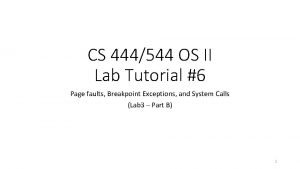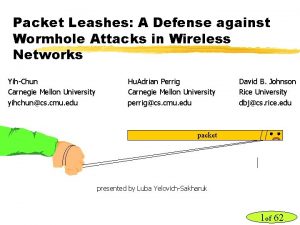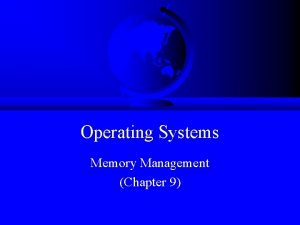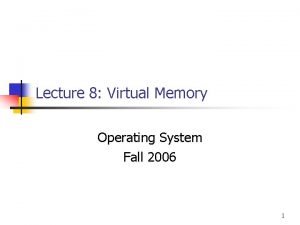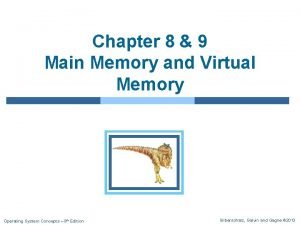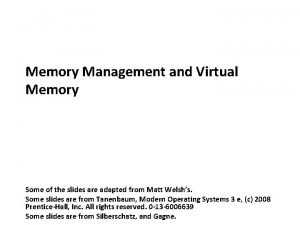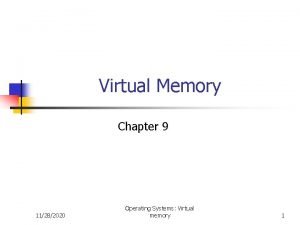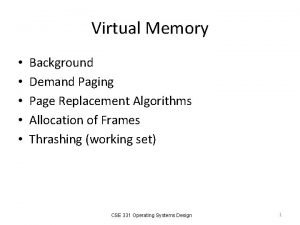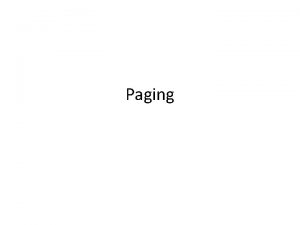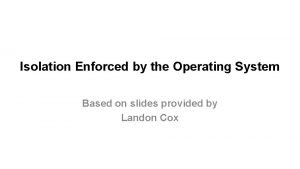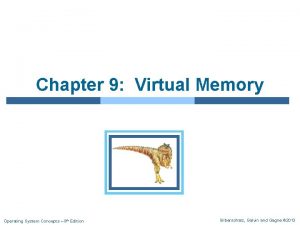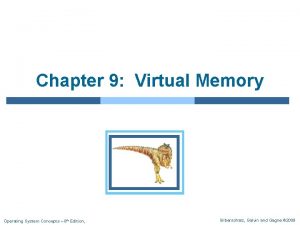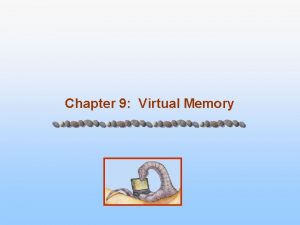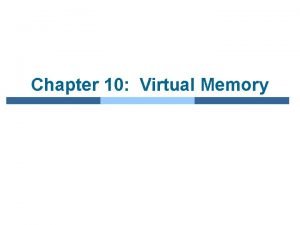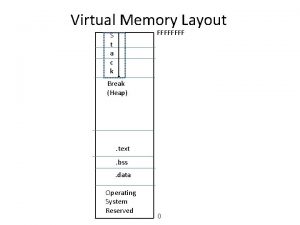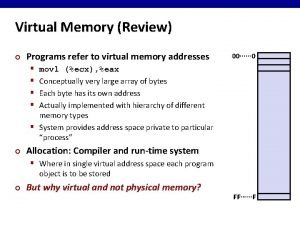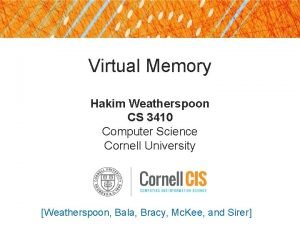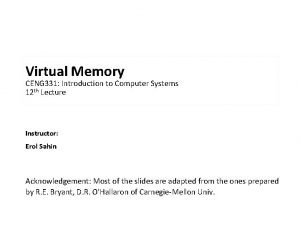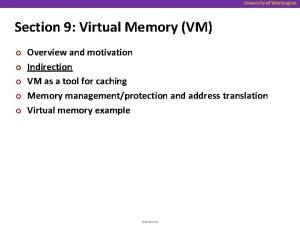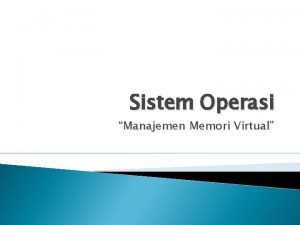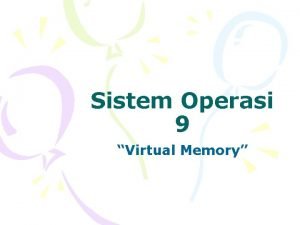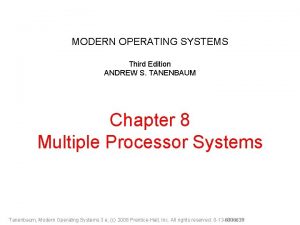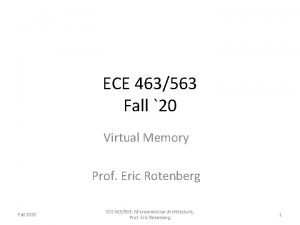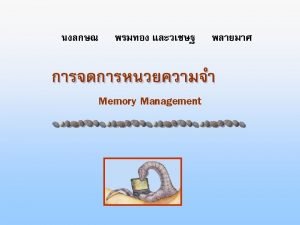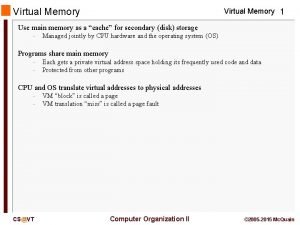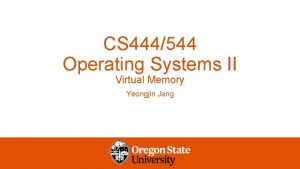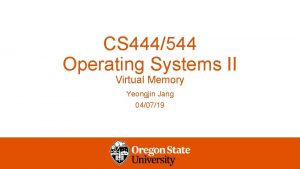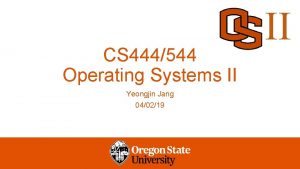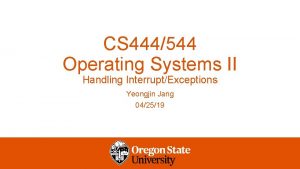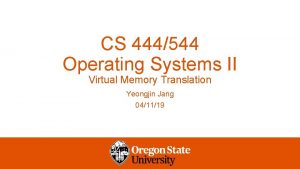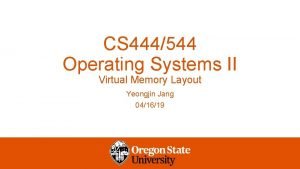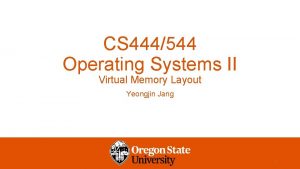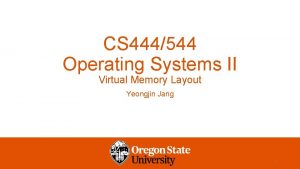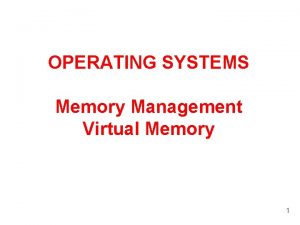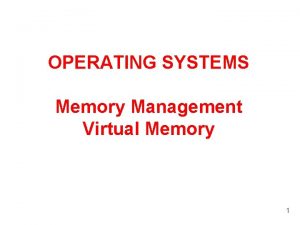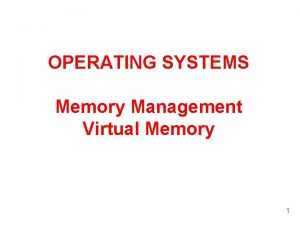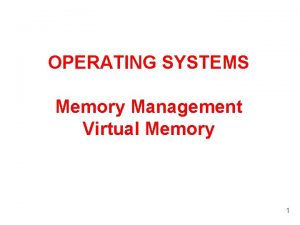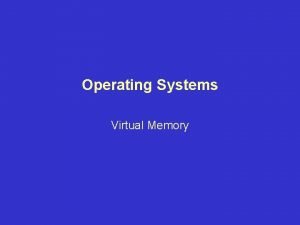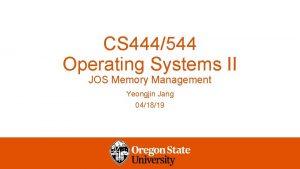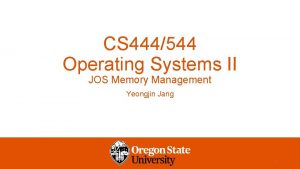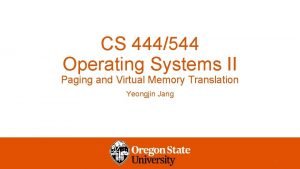CS 444544 Operating Systems II Virtual Memory Yeongjin


















































![In kern/entrypgdir. c 0 xf 0001000 will consult entry_pgtable[1] -> 0 x 001000 | In kern/entrypgdir. c 0 xf 0001000 will consult entry_pgtable[1] -> 0 x 001000 |](https://slidetodoc.com/presentation_image_h2/fad9501ac4bd5dbce6f0ccbab33b5571/image-51.jpg)




- Slides: 55

CS 444/544 Operating Systems II Virtual Memory Yeongjin Jang 04/09/19

Recap – Real Mode • Real mode segmentation, how? • seg * 16 + offset • [b 000: b 7 ff] => 0 xb 000 * 16 + 0 xb 7 ff = 0 xbb 7 ff • What is A 20? • [f 800: 8001] => 0 x 100001? • [f 800: 8001] => 0 x 1? • FYI, segment registers are: • • • %cs – code segment %ds – data segment %es – extra segment %fs %gs %ss – stack segment Image from: https: //upload. wikimedia. org/wikipedia/commons/thumb/d/db/Overlapping_realmode_segments. svg

Recap - JOS Boot Sequence • 0 xf 000: 0 xffff – BIOS • Loads boot sector – runs 0 x 7 c 00 • Enable A 20 • Enable protected mode (enabling 4 GB memory access) • Read kernel ELF (Executable Linkable Format) • …

No Memory Privilege in Real Mode • Suppose two program runs at the same time Main Memory Program A • Program A attempts to modify memory used by program B • No SECURITY! Program B

i 386 Protected Mode • Look at GDT (Global Descriptor Table) • Indexed by a segment register • (selector) • Retrieve base address • Address = base + offset • Can access if (offset < limit) or • Can access if (offset < limit * 4096) • Depending on the values in flags! Images from: https: //sipb. mit. edu/iap/6. 828/files/x 86_translation_and_registers. pdf

i 386 Protected Mode • Base • Any 32 -bit address • Limit • 20 -bit, but could be multiplied by 4096 bytes • E. g. , 1 means 4096, 2 means 8192, etc. Images from: https: //sipb. mit. edu/iap/6. 828/files/x 86_translation_and_registers. pdf https: //wiki. osdev. org/Global_Descriptor_Table

i 386 Protected Mode • G - Granularity (0 = byte, 1 = page) • 0: Limit will be byte granularity (i. e. , limit, only access 220, 1 MB) • 1: Limit will be page granularity (i. e. , limit * 4096, 220 * 216 = 232) • D – Default operand size (0 = 16 -bit, 1 = 32 -bit) • Set the values of IP/SP with respect to this bit • R, X – Readable/Executable • DPL – Descriptor Privilege Level (a. k. a. Ring Level) • 0 (highest priv), 1, 2, 3 (lowest priv) For more information: https: //en. wikipedia. org/wiki/Protected_mode

Protected Mode - Examples • 0 x 0: 0 x 8080 • Base: 0 x 0 • Limit (addr): 0 xfffff 000 • Offset: 0 x 8080 • Address: 0 x 8080 GDT index 32 -bit Base 20 -bit Limit 12 -bit Flags 16 0 x 31310000 0 x 1 G=1 8 0 x 40000000 0 x 80000 G=1 0 0 xfffff G=1

Protected Mode - Examples • 0 x 8: 0 x 8080 • Base: 0 x 40000000 • Limit (addr): 0 x 8000000 • Offset: 0 x 8080 • Address: 0 x 40008080 GDT index 32 -bit Base 20 -bit Limit 12 -bit Flags 16 0 x 31310000 0 x 1 G=1 8 0 x 40000000 0 x 80000 G=1 0 0 xfffff G=1

Protected Mode - Examples • 0 x 10: 0 x 333 • Base: 0 x 31310000 • Limit (addr): 0 x 1000 • Offset: 0 x 333 • Address: 0 x 31310333 • 0 x 10: 0 x 8080 • • • Base: 0 x 31310000 Limit (addr): 0 x 1000 Offset: 0 x 8080 Offset > limit Access denied! GDT index 32 -bit Base 20 -bit Limit 12 -bit Flags 16 0 x 31310000 0 x 1 G=1 8 0 x 40000000 0 x 80000 G=1 0 0 xfffff G=1

Protected Mode – Memory Privilege • DPL (Descriptor Privilege Level) • Protected mode – four levels of memory privilege • 0 – highest, OS kernel • 1 – OS kernel ----------------------- • 2 – highest user-level privilege • 3 – user-level privilege Kernel: for privileged OS operations… User: for unprivileged applications…

Protected Mode – Memory Privilege • No memory privilege in real mode • Protected mode – four levels of memory privilege • 0 – highest, OS kernel • 1 – OS kernel ---------------------- • 2 – highest user-level privilege • 3 – user-level privilege • Typically, 0 is for kernel, 3 is for user… Image from: https: //en. wikipedia. org/wiki/File: Priv_rings. svg

Descriptor Privilege Level Defines Ring Level • CPL = Current Privilege Level • Defined in the last 2 bits of the %cs register • You can change %cs only via lcall/ljmp/trap/int GDT index 32 -bit Base 20 -bit Limit 12 -bit Flags 16 USER 0 x 31310000 0 x 1 G=1, DPL=3 8 KERNEL 0 x 40000000 0 x 80000 G=1, DPL=0 0 KERNEL 0 x 0 0 xfffff G=1, DPL=0

Descriptor Privilege Level Defines Ring Level • CPL = Current Privilege Level • Defined in the last 2 bits of the %cs register • You can change %cs only via lcall/ljmp/trap/int • Examples • • %cs == 0 x 8 %cs == 0 x 13 %cs == 0 x 10 %cs == 0 xb == 1000 in binary, last 2 bits are ZERO -> KERNEL! == 10011 in binary, last 2 bits are 3 -> USER! == 10000 in binary, last 2 bits are 0 -> KERNEL! == 1011…. GDT index 32 -bit Base 20 -bit Limit 12 -bit Flags 16 USER 0 x 31310000 0 x 1 G=1, DPL=3 8 KERNEL 0 x 40000000 0 x 80000 G=1, DPL=0 0 KERNEL 0 x 0 0 xfffff G=1, DPL=0

Descriptor Privilege Level Defines Ring Level • CPL = Current Privilege Level • Defined in the last 2 bits of the %cs register • You can change %cs only via lcall/ljmp/trap/int • mov %ax, %cs impossible! • Can only move down… • CPL==0, then ljmp 0 x 3: 0 x 1234 is possible • CPL==3, then ljmp 0 x 0: 0 x 1234 is impossible GDT index 32 -bit Base 20 -bit Limit 12 -bit Flags 16 USER 0 x 31310000 0 x 1 G=1, DPL=3 8 KERNEL 0 x 40000000 0 x 80000 G=1, DPL=0 0 KERNEL 0 x 0 0 xfffff G=1, DPL=0

x 86 Memory Privileges • CPL = Current Privilege Level • Defined in the last 2 bits of the %cs register • You can only change %cs via lcall/ljmp/trap/int • RPL = Requester Privilege Level • Ring switch rule • CPL <= DPL • RPL <= DPL • Defined in the last 2 bits of any segment register • Must meet both conditions. . • DPL = Descriptor Privilege Level • Defined in the GDT

Enabling Protected Mode (part 1): Create Global Descriptor Table (GDT) • In boot/boot. S • %cs to point 0 ~ 0 xffff in DPL 0 • %ds to point 0 ~ 0 xffff in DPL 0 • Only kernel can access those two segment GDT index 32 -bit Base 20 -bit Limit 12 -bit Flags 16 0 x 0 0 xfffff G=1, W DPL=0 8 0 x 0 0 xfffff G=1, XR DPL=0 0 0

Enabling Protected Mode (part 2): Change CR 0 (Control Register 0) Set PE (Protected enabled) to 1 will enable Protected Mode In JOS: 1. Load GDT 2. Read CR 0, store it to eax 3. Set PE_ON (1) on eax 4. Put eax back to CR 0 (PE_ON to CR 0!!)

How to Change CPL? • ljmp (instruction) • Long jump 0 x 8 == 1000, Last 2 bits are zero. .

Protected Mode Summary • Segment access via GDT • Base + Offset < Limit * 4096 • Last two bits in %cs segment - CPL • Memory Privilege - Ring level • 0 for OS kernel • 3 for user application • Changing CR 0 to enable protected mode • CR 0_PE_ON == 1, set via eax • Changing CPL? • ljmp %cs: xxxxx, set the last 2 bits of %cs as 0 for kernel. .

Virtual Memory • Three goals • Transparency • Efficiency • Protection

Uniprogramming Environment • Run one program Stack - 1 Program Data - 1 • The program can use memory space freely… Program Code - 1 Free (576 KB) 0 x 10000 ~ 0 xa 0000 (64 KB ~ 640 KB) OS 0 x 00000 ~ 0 x 10000 (0 ~ 64 KB)

Uniprogramming Environment • Run one program • The program can use memory space freely… Stack (64 KB) Stack -1 0 x 80000 ~ 0 x 90000 (512 KB ~ 576 KB) Free (576 KB) 0 x 10000 Data ~ 0 xa 0000 Program (64 KB) (64 KB ~~640 KB) Program Data -1 0 x 40000 0 x 50000 (256 KB ~ 320 KB) Program Code - 1 OS 0 x 00000 ~ 0 x 10000 (0 ~ 64 KB)

Uniprogramming Environment • Run one program • The program can use memory space freely… Free (64 KB) 0 x 90000 ~ 0 xa 0000 (576 KB ~ 640 KB) Stack - 1 (64 KB) 0 x 80000 ~ 0 x 90000 (512 KB ~ 576 KB) Free (192 KB) 0 x 50000 ~ 0 x 80000 (320 KB ~ 512 KB) Program Data - 1 (64 KB) 0 x 40000 ~ 0 x 50000 (256 KB ~ 320 KB) Free (64 KB) 0 x 30000 ~ 0 x 40000 (192 KB ~ 256 KB) Program Code - 1 (128 KB) 0 x 10000 ~ 0 x 30000 (64 KB ~ 192 KB) OS 0 x 00000 ~ 0 x 10000 (0 ~ 64 KB)

Multi-programming Environment • Run two programs Stack - 2 (64 KB) Program Data - 2 (64 KB) Program Code - 2 (128 KB) Free (64 KB) 0 x 90000 ~ 0 xa 0000 (576 KB ~ 640 KB) Stack - 1 (64 KB) 0 x 80000 ~ 0 x 90000 (512 KB ~ 576 KB) Free (192 KB) 0 x 50000 ~ 0 x 80000 (320 KB ~ 512 KB) Program Data - 1 (64 KB) 0 x 40000 ~ 0 x 50000 (256 KB ~ 320 KB) Free (64 KB) 0 x 30000 ~ 0 x 40000 (192 KB ~ 256 KB) Program Code - 1 (128 KB) 0 x 10000 ~ 0 x 30000 (64 KB ~ 192 KB) OS 0 x 00000 ~ 0 x 10000 (0 ~ 64 KB)

Multi-programming Environment • Run two programs • System’s memory usage determines allocation • Program need to be aware of the environment • Where does system loads my code? • You can’t determine… system does. . No Transparency… Free (64 KB) 0 x 90000 ~ 0 xa 0000 Stack - 2 (64 KB) (576 KB ~ 640 KB) Stack - 1 (64 KB) 0 x 80000 ~ 0 x 90000 (512 KB ~ 576 KB) Free (192 KB) 0 x 50000 ~ 0 x 80000 Program Code - 2 (128 KB) (320 KB ~ 512 KB) Program Data - 1 (64 KB) 0 x 40000 ~ 0 x 50000 (256 KB ~ 320 KB) Free (64 KB) Program Data - 2 (64 KB) 0 x 30000 ~ 0 x 40000 (192 KB ~ 256 KB) Program Code - 1 (128 KB) 0 x 10000 ~ 0 x 30000 (64 KB ~ 192 KB) OS 0 x 00000 ~ 0 x 10000 (0 ~ 64 KB)

Multi-programming Environment • Run two programs Stack - 2 (64 KB) Program Data - 2 (64 KB) Program Code - 2 (160 KB) Free (64 KB) 0 x 90000 ~ 0 xa 0000 (576 KB ~ 640 KB) Stack - 1 (64 KB) 0 x 80000 ~ 0 x 90000 (512 KB ~ 576 KB) Free (96 KB) 0 x 68000 ~ 0 x 80000 (416 KB ~ 512 KB) Program Data - 1 (64 KB) 0 x 58000 ~ 0 x 68000 (352 KB ~ 416 KB) Free (128 KB) 0 x 38000 ~ 0 x 58000 (224 KB ~ 352 KB) Program Code - 1 (160 KB) 0 x 10000 ~ 0 x 38000 (64 KB ~ 224 KB) OS 0 x 00000 ~ 0 x 10000 (0 ~ 64 KB)

Multi-programming Environment • Run two programs • Program size: 64 KB + 160 K = • Free mem • 64 + 96 + 128 = 288 KB • Cannot run Program – 2 • Can’t fit… Free (64 KB) 0 x 90000 ~ 0 xa 0000 Stack - 2 (64 KB) (576 KB ~ 640 KB) Stack - 1 (64 KB) 0 x 80000 ~ 0 x 90000 288 KB (512 KB ~ 576 KB) Free (96 KB) Program Data - 2 (64 KB) 0 x 68000 ~ 0 x 80000 (416 KB ~ 512 KB) Program Data - 1 (64 KB) 0 x 58000 ~ 0 x 68000 (352 KB ~ 416 KB) Free (128 KB) Program Code - 2 (160 KB) 0 x 38000 ~ 0 x 58000 (224 KB ~ 352 KB) Program Code - 1 (160 KB) 0 x 10000 ~ 0 x 38000 (64 KB ~ 224 KB) Not efficient. . Suffers memory fragmentation problem. . OS 0 x 00000 ~ 0 x 10000 (0 ~ 64 KB)

Multi-programming Environment • Run two programs • What if Program-2’s stack underflows? • What if Program-2’s data overflows? • Without virtual memory • Programs can affect to the other’s execution No isolation. Security problem. Free (64 KB) Stack - 2~ (64 KB) 0 x 90000 0 xa 0000 (576 KB ~ 640 KB) Stack (64 KB) 0 x 80000 ~ 0 x 90000 (512 KB ~ 576 KB) Free (192 KB) Program Code - 2 (128 KB) 0 x 50000 ~ 0 x 80000 (320 KB ~ 512 KB) Program Data (64 KB) 0 x 40000 ~ 0 x 50000 (256 KB ~ 320 KB) Free (64 KB) Program Data - 2 (64 KB) 0 x 30000 ~ 0 x 40000 (192 KB ~ 256 KB) Program Code (128 KB) 0 x 10000 ~ 0 x 30000 (64 KB ~ 192 KB) OS 0 x 00000 ~ 0 x 10000 (0 ~ 64 KB)

Virtual Memory • Three goals • Transparency: does not need to know system’s internal state • Program A is loaded at 0 x 8048000. Can Program B be loaded at 0 x 8048000? • Efficiency: do not waste memory; manage memory fragmentation • Can Program B (288 KB) be loaded if 288 KB of memory is free, regardless of its allocation? • Protection: isolate program’s execution environment • Can we prevent an overflow from Program A from overwriting Program B’s data?

Paging • A method of implementing virtual memory • Split memory into multiple 4, 096 byte blocks (12 -bit) • Last 3 digits of page address are ZERO (in hexadecimal) • Having an indirect map between virtual page and physical page • • Set an arbitrary virtual address for a page, e. g. , 0 x 81815000 Set a physical address to that page as a map, e. g. , 0 x 32000 0 x 81815000 ~ 0 x 81815 fff will be translated into 0 x 32000 ~ 0 x 32 fff

Virtual Memory - Paging Physical Memory • Having an indirect table that maps virt-addr to phys-addr Stack 0 xbffdf 000 Virtual Physical 0 x 8048000 0 x 10000 Program code 0 x 804 a 000 0 x 8049000 0 x 11000 Program code 0 x 8049000 0 x 804 a 000 0 x 14000 0 xbffdf 000 0 x 12000 … … Program code 0 x 8048000 Program code 0 x 14000 Stack 0 x 12000 Program code 0 x 11000 Program code 0 x 10000

Paging: Virtual Memory • Having an indirect table that maps virt-addr to phys-addr Stack-2 0 xbffdf 000 Stack 0 xbffdf 000 Program code-2 0 x 804 a 000 Program code-2 0 x 8049000 Program code-2 0 x 8048000 Program code 0 x 8048000 Virtual Physical 0 x 8048000 0 x 10000 0 x 8049000 0 x 11000 0 x 804 a 000 0 x 14000 0 xbffdf 000 0 x 12000 … … Virtual-2 Physical-2 0 x 8048000 0 x 13000 0 x 8049000 0 x 15000 0 x 804 a 000 0 x 16000 0 xbffdf 000 0 x 17000 … … Physical Memory Stack-2 0 x 17000 Program code-2 0 x 16000 Program code-2 0 x 15000 Program code 0 x 14000 Program code-2 0 x 13000 Stack 0 x 12000 Program code 0 x 11000 Program code 0 x 10000

Transparency: does not need to know system’s internal state Program A is loaded at 0 x 8048000. Paging: Virtual Memory Can Program B be loaded at 0 x 8048000? • Having an indirect table that maps virt-addr to phys-addr Stack-2 0 xbffdf 000 Stack 0 xbffdf 000 Program code-2 0 x 804 a 000 Program code-2 0 x 8049000 Program code-2 0 x 8048000 Program code 0 x 8048000 Virtual Physical 0 x 8048000 0 x 10000 0 x 8049000 0 x 11000 0 x 804 a 000 0 x 14000 0 xbffdf 000 0 x 12000 … … Virtual-2 Physical-2 0 x 8048000 0 x 13000 0 x 8049000 0 x 15000 0 x 804 a 000 0 x 16000 0 xbffdf 000 0 x 17000 … … Physical Memory Stack-2 0 x 17000 Program code-2 0 x 16000 Program code-2 0 x 15000 Program code 0 x 14000 Program code-2 0 x 13000 Stack 0 x 12000 Program code 0 x 11000 Program code 0 x 10000

Efficiency: do not waste memory Can Program B (288 KB) be loaded if Paging: Virtual Memory only 288 KB of memory is free, regardless of its allocation? • Having an indirect table that maps virt-addr to phys-addr Stack-2 0 xbffdf 000 Stack 0 xbffdf 000 Program code-2 0 x 804 a 000 Program code-2 0 x 8049000 Program code-2 0 x 8048000 Program code 0 x 8048000 Virtual Physical 0 x 8048000 0 x 10000 0 x 8049000 0 x 11000 0 x 804 a 000 0 x 14000 0 xbffdf 000 0 x 12000 … … Virtual-2 Physical-2 0 x 8048000 0 x 13000 0 x 8049000 0 x 15000 0 x 804 a 000 0 x 16000 0 xbffdf 000 0 x 17000 … … Physical Memory Stack-2 0 x 17000 Program code-2 0 x 16000 Program code-2 0 x 15000 Program code 0 x 14000 Program code-2 0 x 13000 Stack 0 x 12000 Program code 0 x 11000 Program code 0 x 10000

Protection: isolate program’s execution environment Can we prevent an overflow from Program A from Paging: Virtual Memory overwriting Program B’s data? Stack-2 0 xbffdf 000 No mappings, FAULT! Stack 0 xbffdf 000 No mappings, FAULT! Program code-2 0 x 804 a 000 Program code-2 0 x 8049000 Program code-2 0 x 8048000 Program code 0 x 8048000

Page Table • A table that stores virtual address to physical address mapping… • We need to create this per each process… Virtual Physical Virtual-2 Physical-2 0 x 8048000 0 x 10000 0 x 8048000 0 x 13000 0 x 8049000 0 x 11000 0 x 8049000 0 x 15000 0 x 804 a 000 0 x 14000 0 x 804 a 000 0 x 16000 0 xbffdf 000 0 x 12000 0 xbffdf 000 0 x 17000 … …

Page Directory / Table • We access page table by virtual address • Page size: 4 KB (12 bits) 31 • Page number: 20 bits • What is the page number and offset of • 0 x 8048000 • 0 xb 7 ff 3100 12 Page number 0 Offset

Page Directory / Table • In x 86 (32 -bit), CPU uses 2 -level page table • 10 -bit directory index 31 Directory Index (10 -bits) 31 Table index (10 -bits) 22 0 Offset Page number • 10 -bit page table index • 12 -bit offset 12 12

Address Translation 31 12 Virtual address (32 -bits) Offset (12 -bits) Page number (20 -bits) Directory Index (10 -bits) 31 Table index (10 -bits) 22 12 Page Directory Entry Page Table Entry 0 Addr PT 0 Addr page 1 Addr PT 1 Addr page 2 Addr PT 2 Addr page 1024 Addr PT 1024 Addr page 0

Address Translation Example 31 12 0 0 x 08048000 Offset (12 -bits) 0 x 000 Page number (20 -bits) 0 x 08048 Directory Index (10 -bits) 0 x 20 31 Table index (10 -bits) 0 x 48 22 12 Page Directory Entry PT 10 Page Table Entry 0 Addr PT 1 0 NO MAPPING . . Addr PT 2 0 x 48 0 x 10000 0 x 20 Addr PT 10 0 x 49 0 x 11000 0 x 3 ff Addr PT 500 0 x 4 a 0 x 50000 Physical access Virtual Physical 0 x 8048000 0 x 10000 0 x 8049000 0 x 11000 0 x 804 a 000 0 x 50000

Page Table Entry • Address translation is from virtual page to physical page • E. g. , 0 x 8048000 -> 0 x 11000 • We do not need to translate lower 12 bits • E. g. , 0 x 8048001 -> 0 x 8048000 + 0 x 001 -> 0 x 11000 + 0 x 001 • So page table entry only uses higher 20 bits to store physical page address • Lower 12 bits remaining as the same • We do not translate the lower 12 bits!

Address Translation Examples • Virtual addresss 0 x 8048338 • • Virtual page number: 0 x 8048 Offset: 0 x 338 Physical page number: 0 x 10 Physical address: 0 x 10 (000) + 0 x 338 = 0 x 10338 • Virtual address 0 x 443325 af • • Virtual page number: 0 x 44332 Offset: 0 x 5 af Physical page number: 0 x 33885 Physical address: 0 x 33885000 + 0 x 5 af = 0 x 338855 af Virtual Physical 0 x 8048000 0 x 10000 0 x 8049000 0 x 11000 0 x 804 a 000 0 x 14000 0 xbffdf 000 0 x 12000 0 x 44332000 0 x 33885000 Virtual Physical 0 x 8048 0 x 10 0 x 8049 0 x 11 0 x 804 a 0 x 14 0 xbffdf 0 x 12 0 x 44332 0 x 33885

PDE, PTE 0: kernel, 1: user Page Directory Entry PT 10 Page Table Entry 0 Addr PT 1 0 NO MAPPING . . Addr PT 2 0 x 48 0 x 10000 0 x 20 Addr PT 10 0 x 49 0 x 11000 0 x 3 ff Addr PT 500 0 x 4 a 0 x 50000

Paging in x 86 • Can be enabled via CR 0 • Page table address (physical) need to be stored at CR 3

Paging in x 86 Virtual Address

Paging in x 86 • In JOS (kern/entry. S) Set cr 3 to point the address of page directory Turn on CR 0_PG! • After CR 0_PG is up (paging is turned on) • All address access regarded as virtual address

How can we access physical address • After CR 0_PG is up (paging is turned on) • All address access regarded as virtual address • What if we would like to access the physical address 0 x 100010? • Our kernel is at physical address 0 x 100000 ~ 0 x 110000 • What’s the virtual addresses of those area?

How can we access physical address 4 GB virtual address space • In JOS, we will map 0 xf 0000000 ~ 0 xffff to • Physical address • 0 x 0000 ~ 0 x 0 fffffff • 256 MB Region • 0 xf 0100010 -> 0 x 0010 • 0 xf 1333358 -> 0 x 01333358 0 xf 0000000 – 0 xffff (256 MB) 256 MB physical address space

In kern/entrypgdir. c Entry_pgdir only contains two entries; 0 ~ 0 x 400000 to 0 ~ 0 x 400000 (not writable) 0 xf 0000000 ~ 0 xf 0400000 to 0 ~ 0 x 400000 (writable)
![In kernentrypgdir c 0 xf 0001000 will consult entrypgtable1 0 x 001000 In kern/entrypgdir. c 0 xf 0001000 will consult entry_pgtable[1] -> 0 x 001000 |](https://slidetodoc.com/presentation_image_h2/fad9501ac4bd5dbce6f0ccbab33b5571/image-51.jpg)
In kern/entrypgdir. c 0 xf 0001000 will consult entry_pgtable[1] -> 0 x 001000 | PTE_P | PTE_W Phyaddr: 0 x 1000

Page • A page • A 4, 096 (4 KB) block of memory • Why having a block? • How large does the page table should be to map 4 GB (32 -bit space)? • • If a block is 1 GB – 4 entries * pointer (32 -bit, 4 byte) = 16 byte long If a block is 4 MB – 1024 entries * pointer = 4, 096 bytes, 4 KB long If a block is 4 KB – 1048576 entries * pointer = 4 MB long If a block is 1 byte – 4294967296 entries = 4 GB… NONO… Design consideration: Size of page table matters! Virtual Physical 0 x 8048000 0 x 10000 0 x 8049000 0 x 11000 0 x 804 a 000 0 x 50000

Page (cont’d) • A page • A 4, 096 (4 KB) block of memory • Why 4 KB in Intel x 86? • How much memory do you need to allocate 1 byte? • • 1 GB page – 1 GB 4 MB page – 4 MB 4 KB page – 4 KB 1 B page – 1 B Design consideration: Memory fragmentation matters! Virtual Physical 0 x 8048000 0 x 10000 0 x 8049000 0 x 11000 0 x 804 a 000 0 x 50000

Page Size / Page Table Size • If a page size is too small, it requires a big page table • • 1 B, 4 GB 4 KB, 4 MB, 4 KB 1 G, 16 B • If a page size is too big, unused memory in a page will be wasted • • 1 B - 1 B (no waste) 4 KB – 1 B 4 MB – 1 B 1 G – 1 B

x 86 Memory Access
 444544
444544 Yeongjin jang
Yeongjin jang Yeongjin jang
Yeongjin jang Virtual memory
Virtual memory Demand paging in virtual memory
Demand paging in virtual memory Page fault
Page fault Virtual memory in memory hierarchy consists of
Virtual memory in memory hierarchy consists of Address binding
Address binding Episodic memory vs semantic memory
Episodic memory vs semantic memory Excplicit memory
Excplicit memory Long term memory vs short term memory
Long term memory vs short term memory Internal memory and external memory
Internal memory and external memory Primary memory and secondary memory
Primary memory and secondary memory Physical memory vs logical memory
Physical memory vs logical memory Which memory is the actual working memory?
Which memory is the actual working memory? Eidetic memory vs iconic memory
Eidetic memory vs iconic memory Shared vs distributed memory
Shared vs distributed memory Virtual memory meaning
Virtual memory meaning Belady's anomaly example
Belady's anomaly example Advantages of virtual memory
Advantages of virtual memory Explain virtual memory in computer architecture
Explain virtual memory in computer architecture Demand paging in virtual memory
Demand paging in virtual memory Virtual memory in os
Virtual memory in os Virtual memory linux
Virtual memory linux Virtual memory os
Virtual memory os Virtual memory
Virtual memory Virtual memory segmentation
Virtual memory segmentation Tlb computer architecture
Tlb computer architecture Virtual memory os
Virtual memory os Virtual memory os
Virtual memory os Virtual memory is commonly implemented by
Virtual memory is commonly implemented by Slab is one or more physically contiguous frames.
Slab is one or more physically contiguous frames. Virtual memory os
Virtual memory os Virtual memory
Virtual memory Kai hierarchy
Kai hierarchy Virtual memory
Virtual memory Stack memory layout
Stack memory layout What virtual memory does
What virtual memory does Virtual memory
Virtual memory Virtual memory
Virtual memory Virtual memory reddit
Virtual memory reddit Virtual memory
Virtual memory Virtual address
Virtual address Virtual memory
Virtual memory Virtual memory
Virtual memory Virtual memory indirection
Virtual memory indirection Karakteristik dari memori virtual
Karakteristik dari memori virtual Implementasi virtual memory
Implementasi virtual memory Shared virtual memory
Shared virtual memory Virtual memory
Virtual memory Memory paging
Memory paging What is virtual memory
What is virtual memory Virtual memory address translation
Virtual memory address translation Process virtual address space
Process virtual address space Nachos virtual memory
Nachos virtual memory Nachos virtual memory
Nachos virtual memory
